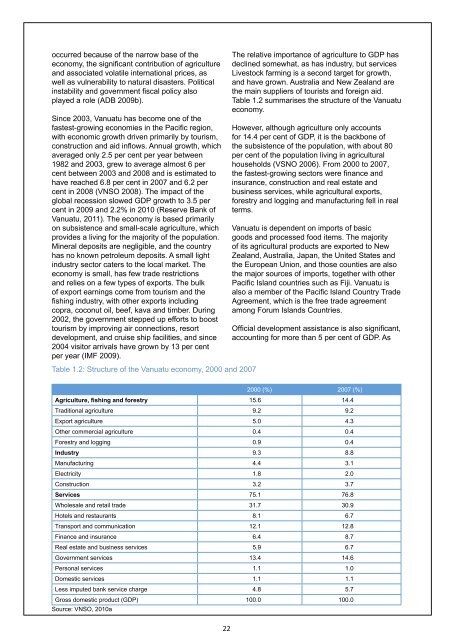Global Study On Child Poverty And Disparities (PDF) - Social Policy ...
Global Study On Child Poverty And Disparities (PDF) - Social Policy ...
Global Study On Child Poverty And Disparities (PDF) - Social Policy ...
You also want an ePaper? Increase the reach of your titles
YUMPU automatically turns print PDFs into web optimized ePapers that Google loves.
occurred because of the narrow base of the<br />
economy, the significant contribution of agriculture<br />
and associated volatile international prices, as<br />
well as vulnerability to natural disasters. Political<br />
instability and government fiscal policy also<br />
played a role (ADB 2009b).<br />
Since 2003, Vanuatu has become one of the<br />
fastest-growing economies in the Pacific region,<br />
with economic growth driven primarily by tourism,<br />
construction and aid inflows. Annual growth, which<br />
averaged only 2.5 per cent per year between<br />
1982 and 2003, grew to average almost 6 per<br />
cent between 2003 and 2008 and is estimated to<br />
have reached 6.8 per cent in 2007 and 6.2 per<br />
cent in 2008 (VNSO 2008). The impact of the<br />
global recession slowed GDP growth to 3.5 per<br />
cent in 2009 and 2.2% in 2010 (Reserve Bank of<br />
Vanuatu, 2011). The economy is based primarily<br />
on subsistence and small-scale agriculture, which<br />
provides a living for the majority of the population.<br />
Mineral deposits are negligible, and the country<br />
has no known petroleum deposits. A small light<br />
industry sector caters to the local market. The<br />
economy is small, has few trade restrictions<br />
and relies on a few types of exports. The bulk<br />
of export earnings come from tourism and the<br />
fishing industry, with other exports including<br />
copra, coconut oil, beef, kava and timber. During<br />
2002, the government stepped up efforts to boost<br />
tourism by improving air connections, resort<br />
development, and cruise ship facilities, and since<br />
2004 visitor arrivals have grown by 13 per cent<br />
per year (IMF 2009).<br />
Table 1.2: Structure of the Vanuatu economy, 2000 and 2007<br />
The relative importance of agriculture to GDP has<br />
declined somewhat, as has industry, but services<br />
Livestock farming is a second target for growth,<br />
and have grown. Australia and New Zealand are<br />
the main suppliers of tourists and foreign aid.<br />
Table 1.2 summarises the structure of the Vanuatu<br />
economy.<br />
However, although agriculture only accounts<br />
for 14.4 per cent of GDP, it is the backbone of<br />
the subsistence of the population, with about 80<br />
per cent of the population living in agricultural<br />
households (VSNO 2006). From 2000 to 2007,<br />
the fastest-growing sectors were finance and<br />
insurance, construction and real estate and<br />
business services, while agricultural exports,<br />
forestry and logging and manufacturing fell in real<br />
terms.<br />
Vanuatu is dependent on imports of basic<br />
goods and processed food items. The majority<br />
of its agricultural products are exported to New<br />
Zealand, Australia, Japan, the United States and<br />
the European Union, and those counties are also<br />
the major sources of imports, together with other<br />
Pacific Island countries such as Fiji. Vanuatu is<br />
also a member of the Pacific Island Country Trade<br />
Agreement, which is the free trade agreement<br />
among Forum Islands Countries.<br />
Official development assistance is also significant,<br />
accounting for more than 5 per cent of GDP. As<br />
2000 (%) 2007 (%)<br />
Agriculture, fishing and forestry 15.6 14.4<br />
Traditional agriculture 9.2 9.2<br />
Export agriculture 5.0 4.3<br />
Other commercial agriculture 0.4 0.4<br />
Forestry and logging 0.9 0.4<br />
Industry 9.3 8.8<br />
Manufacturing 4.4 3.1<br />
Electricity 1.8 2.0<br />
Construction 3.2 3.7<br />
Services 75.1 76.8<br />
Wholesale and retail trade 31.7 30.9<br />
Hotels and restaurants 8.1 6.7<br />
Transport and communication 12.1 12.8<br />
Finance and insurance 6.4 8.7<br />
Real estate and business services 5.9 6.7<br />
Government services 13.4 14.6<br />
Personal services 1.1 1.0<br />
Domestic services 1.1 1.1<br />
Less imputed bank service charge 4.8 5.7<br />
Gross domestic product (GDP) 100.0 100.0<br />
Source: VNSO, 2010a<br />
22
















